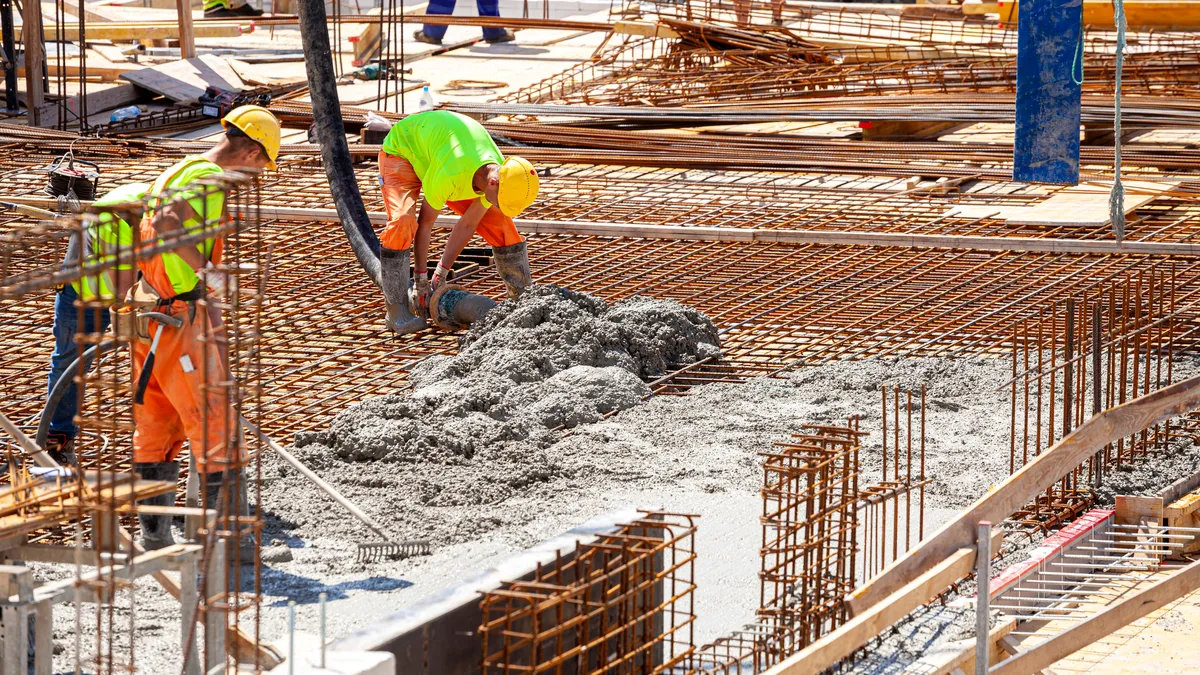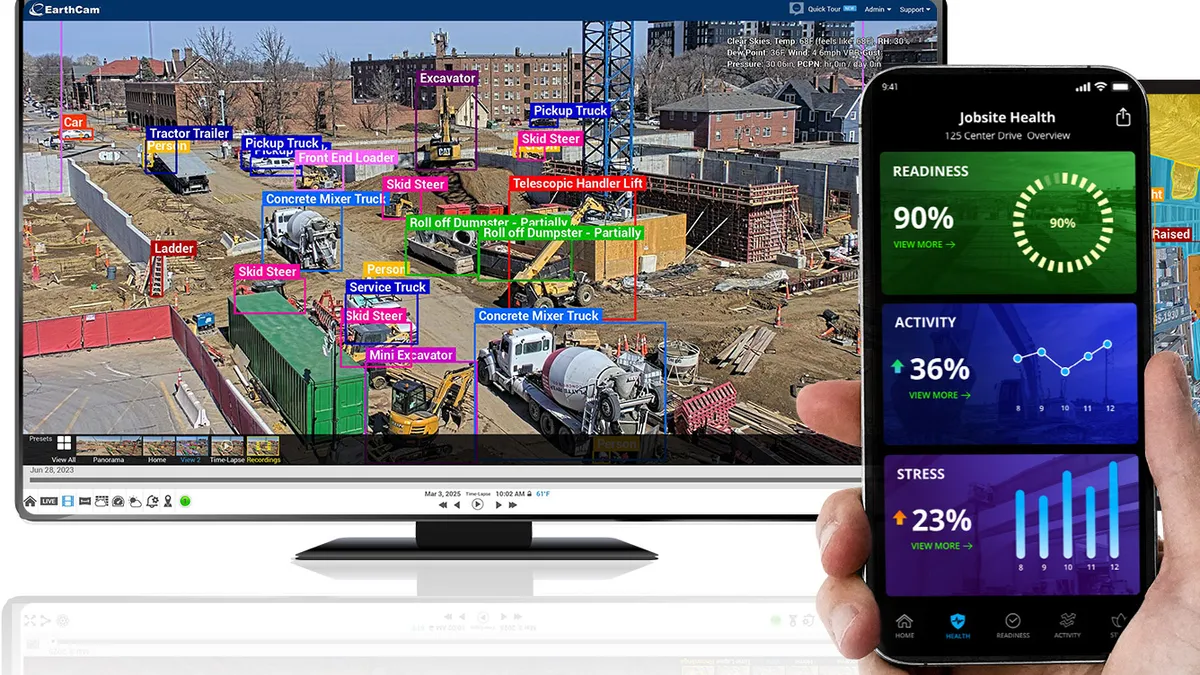Contractors have likely heard of low-carbon concrete, used in megaprojects like Amazon’s second headquarters in Arlington, Virgina, and Microsoft’s Quincy, Washington, data center. While it is not yet the norm on jobsites, the use of greener cement mixes is growing rapidly.
Part of this growth has been spurred by the federal government, which is developing global warming potential requirements for concrete as part of its Buy Clean initiative to be used to award funding for its projects. The federal government is creating these requirements to enable comparisons of the environmental impacts of different materials.
Concrete is the literal foundation of modern building — the second-most used substance on Earth after water — but also contributes at least 8% of all human-caused carbon emissions, according to a University of Rochester study. There are now a wide variety of low-carbon mixes and carbon sequestration methods on the market that have a lower environmental impact than standard Portland cement.
There are many considerations for contractors regarding these new formulations. Green mixes typically behave differently from Portland cement alone, and availability of a given mix in a given area varies since concrete is regionally produced.
Using one of these materials for the first time might be intimidating, but there are simple ways to get started, said panelists at the 2023 Greenbuild International Conference and Expo in Washington, D.C., last month. Here are some of their tips on how to experiment with green concrete successfully.
Start small
The first time trying a low-carbon material, don’t use it for the whole project — start with a low-stakes component that requires only minimal load bearing, such as rat slabs, temporary access mats, curbs or landscaping walls, said Lindsey Maclise, licensed structural engineer and principal with San Francisco-based Forell | Elsesser Structural Engineers.
Use these test projects to gain an understanding of how the material behaves, and to win over more skeptical members of the project team.
Make time for testing
Low-carbon concrete typically uses less cement by substituting some percentage for supplementary cementing materials such as fly ash, slag and silica fume — all industrial byproducts that can perform a similar binding role. SCMs can be used individually with Portland or blended cement and in different combinations, according to the Portland Cement Association.
Do more test cylinders when first using a new cement, said Maclise. Try a few different types of low-carbon mixes and see what works best for your needs.
Find the right client
Contractors should be selective about the clients they partner with to first attempt a more elaborate low-carbon concrete project, according to Jessie Buckmaster, director of sustainability at San Francisco-headquartered Hathaway Dinwiddie Construction. Some owners put greater value in reducing the carbon footprint of their project than others and are more willing to experiment — and to pay for the cost of experimentation.
As the market goes through the process of adjustment to this flood of new options, low-carbon concrete continues to cost more than Portland cement. Fifty years ago, fly ash mixes similarly were new and came at a premium, but have now become commonplace, Maclise said. Prices vary but are going down, and sometimes green mixes qualify for carbon offsets, said Buckmaster. Work with the owner to set bid-leveling criteria to account for low-carbon concrete.
Talk to your supplier
There are now at least dozens of types of low-carbon cements on the market, but not all are in mass production or available in every region. Talk with your supplier about what green mixes can service a given project, said Juan Gonzalez, manager of strategic development and sustainability at Central Concrete Supply in San Jose, California. Some useful questions to ask your supplier include:
- Which low-carbon mixes are available in your concrete catalog?
- What are your low-carbon concrete strategies?
- What SCMs are available to mix into Portland cement?
- What are ways to bring carbon-reduction to the next level on your project?
There’s a significant amount of overdesigning with low-carbon mixes since they’re still new, said Gonzalez. It’s important to share concrete field data with suppliers so they can use the feedback to requalify low-carbon mixes for their actual design strength.
Collaborate with team members
The GC, concrete supplier and structural engineer should all meet up front to ensure mixes are optimized to minimize global warming potential and to discuss how to manage the project timeline to accommodate the new formulations, said Maclise. The structural engineer should be involved throughout the process to make the experiment successful, said Maclise, and it’s also important to collaborate with the design and preconstruction teams.
Be prepared for pushback
Sometimes, engineers who are not yet familiar with low-carbon mixes are resistant to change, but contractors can sometimes nudge engineers out of their comfort zone, said Buckmaster. Let them know that reducing the carbon footprint is a priority, and connect them with other engineers who have used the material to answer questions and offer advice.
“As a GC, don’t be afraid to ask questions, don’t be afraid to suggest new things,” said Buckmaster. “I think sometimes we feel like ‘Well, we just build what they tell us to,’ but I think nowadays we’re in a very unique position where we can really help drive the conversation as well.”
Know the standards
Note that new low-carbon tech and mixes may need approval from governmental authorities. The General Services Administration, which directs the federal government’s procurement efforts, released standards for low-carbon concrete in 2022 that are being tweaked based on industry feedback.
In the meantime, contractors could use these federal benchmarks to guide their maximum embodied carbon limit, or carbon budget, for their project, said Prateek Jain, senior environmental designer at Atelier Ten USA in San Francisco.
Adjust the project schedule
Expect low-carbon mixes to behave differently from Portland cement, Maclise said. Green concrete mixes may take longer to set and have a slower strength gain, so contractors should adjust project schedules accordingly. Coordinate work hours and formwork rotation, considering longer cure times as well as season and expected extreme temperatures.
Ask for mix design submittals early to allow for testing, as well as sample environmental product declarations, Buckmaster advised.
Have a backup plan
Get used to assumed overstrength in design, or strength in excess of seismic code requirements, said Maclise, and don’t be nervous about not hitting overstrength numbers. Know the local building codes and their true requirements, she said, and know your “outs,” or alternative ways to add strength and still meet requirements for a given part of a project if the concrete doesn’t set as anticipated.
More test cylinders will likely be needed to give contractors a more accurate sense of how the material behaves, said Maclise, and tools like maturity sensors can help give peace of mind. Have alternative mixes ready that are still within the project's carbon budget in case one doesn’t perform as it’s supposed to, but don’t give up after a bad pour.
“Cement manufacturing is pretty carbon-intensive and cement drives the high carbon content of concrete,” said Jain. “By encouraging these new technologies, even if it’s at a small scale, what we really want to do is to send market signals to manufacturers to decarbonize.”
The Greenbuild conference is owned by Informa, parent company of Industry Dive.




















